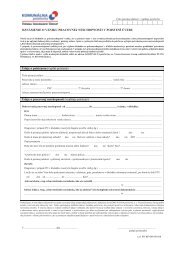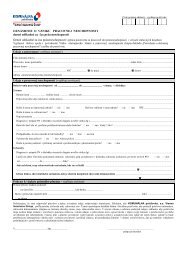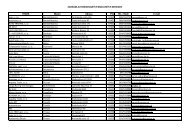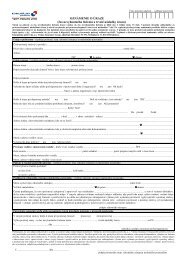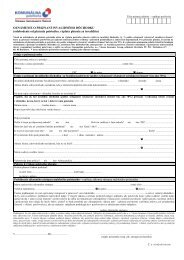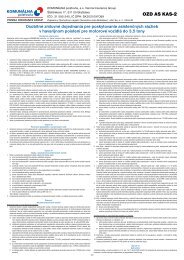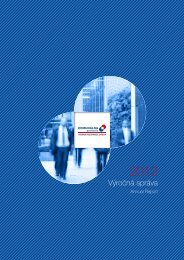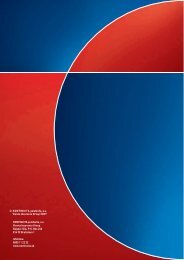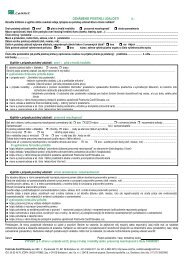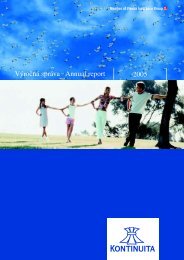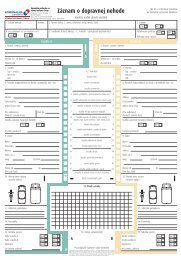(Všetky údaje su v tisícoch eur, pokiaľ nie je uvedené inak.)Novela IAS 32 – Finančné nástroje s právom spätného odpredaja a záväzky vznikajúce prilikvidácii a novela IAS 1 (novela účinná pre účtovné obdobia začínajúce po 1. januári <strong>2009</strong>).Novela vyžaduje, aby určité finančné nástroje, ktoré spĺňajú definíciu finančného záväzku, boliklasifikované ako vlastné imanie. Spoločnosť nepredpokladá, že by uvedený štandard ovplyvnil jejúčtovnú závierku. Novela štandardu bola schválená Európskou Úniou v januári <strong>2009</strong>.IAS 23, Náklady na pôžičky a úvery (štandard novelizovaný v marci 2007; novela účinná preúčtovné obdobia začínajúce po 1. januári <strong>2009</strong>). Hlavnou zmenou v porovnaní s pôvodným znenímje zrušenie možnosti vykázať priamo do nákladov úrokové a iné náklady na pôžičky a úveryvzťahujúce sa na majetok, ktorého príprava na zaradenie do užívania alebo predaj si vyžadujedlhší čas. Novelizovaný štandard sa aplikuje prospektívne na náklady na pôžičky a úvery týkajúcesa obstarania majetku, ktorý bude aktivovaný 1. januára <strong>2009</strong> alebo neskôr. Spoločnosť nepredpokladáže novelizovaný štandard bude mať dopad na jej účtovnú závierku. Zmena tohto štandardubola schválená Európskou Úniou v decembri 2008.IAS 1, Prezentácia účtovnej závierky (štandard novelizovaný v septembri 2007; novela účinnápre účtovné obdobia začínajúce po 1. januári <strong>2009</strong>). Hlavnou zmenou v porovnaní s pôvodnýmznením je nahradenie výkazu ziskov a strát výkazom celkových ziskov a strát, ktorý bude obsahovaťaj všetky zmeny vlastného imania netýkajúce sa vlastníkov spoločnosti, napríklad preceneniefinančného majetku určeného na predaj. Ako alternatívne riešenie bude môcť spoločnosť prezentovaťdva výkazy: samostatný výkaz ziskov a strát ako doteraz a výkaz celkových ziskov a strát.Novelizovaný štandard IAS 1 zavádza taktiež požiadavku prezentovať výkaz o finančnej situácii(súvahu) k počiatočnému dňu porovnateľného účtovného obdobia v prípade, že došlo k zmeneporovnateľných údajov z dôvodu reklasifikácie položiek, zmeny účtovných postupov či opravychýb. Spoločnosť predpokladá, že novela ovplyvní prezentáciu jej účtovnej závierky, ale nebudemať dopad na vykazovanie a oceňovanie určitých transakcií a zostatkov. Zmena tohto štandardubola schválená Európskou Úniou v decembri 2008.<strong>Výročná</strong> <strong>správa</strong> <strong>2009</strong> I Annual Report <strong>2009</strong> KOMUNÁLNA poisťovňa a.s., Vienna Insurance Group100Podmienky vzniku nároku a zrušenia – Novela IFRS 2, Platby na báze podielov (vydaná vjanuári 2008; účinná pre účtovné obdobia začínajúce po 1. januári <strong>2009</strong>). Novela objasňuje, že ibapodmienky služby a podmienky výkonu predstavujú podmienky vzniku nároku na platby na bázepodielov. Ostatné podmienky pre platby na báze podielov sa nepovažujú za podmienky nároku.Novela špecifikuje, že všetky zrušenia, či už zo strany spoločnosti alebo iných strán, musia byť posudzovanéz účtovného hľadiska rovnako. Novela nemá dopad na účtovnú závierku Spoločnosti.Zmena tohto štandardu bola schválená Európskou Úniou v decembri 2008.IFRIC 13, Vernostné programy pre zákazníkov (interpretácia vydaná v júni 2007; účinná preročné účtovné obdobia začínajúce po 1. júli 2008). Interpretácia vysvetľuje, že ak sa pri predajitovaru alebo služieb poskytuje zákazníkom prísľub vernostnej odmeny (napr. body alebo bezodplatnéposkytnutie tovaru), ide o viacprvkové transakcie a úhrada prijatá od zákazníka sa mározdeliť medzi jednotlivé zložky transakcie na báze reálnych hodnôt. Interpretácia IFRIC 13 nie jerelevantná pre činnosť Spoločnosti, pretože Spoločnosť neposkytuje vernostné programy v akejkoľvekforme. Zmena tohto štandardu bola schválená Európskou Úniou v decembri 2008.IFRIC 15, Dohody o výstavbe nehnuteľností (interpretácia účinná pre účtovné obdobia začínajúcepo 1. januári <strong>2009</strong>). Interpretácia sa týka účtovania výnosov a s nimi súvisiacich nákladovv spoločnostiach zaoberajúcich sa výstavbou nehnuteľností buď priamo alebo prostredníctvomsubdodávateľov a poskytuje návod na určenie toho, či dohody o výstavbe nehnuteľností spadajúdo pôsobnosti IAS 11 alebo IAS 18. Taktiež uvádza kritériá na stanovenie toho, kedy by maliúčtovné jednotky vykazovať výnosy z takýchto transakcií. Interpretácia nemá dopad na účtovnúzávierku Spoločnosti. Zmena tohto štandardu bola schválená Európskou Úniou v júli <strong>2009</strong>.IFRIC 16, Zabezpečenie (hedging) čistej investície v zahraničnej prevádzke (interpretáciaúčinná pre ročné účtovné obdobia začínajúce 1. októbrom 2008 alebo neskôr). Interpretácia vysvetľuje,ktoré kurzové riziká spĺňajú podmienky pre účtovanie o hedgingu a uvádza, že prepočetz funkčnej meny na menu prezentácie nevytvára riziko, na ktoré by sa mohlo aplikovať účtovanie ohedgingu. IFRIC 16 dovoľuje, aby zabezpečovací nástroj vlastnila ľubovoľná spoločnosť resp. spoločnostiv skupine s výnimkou zahraničnej prevádzky, ktorá je sama zabezpečovaná. Interpretáciatiež objasňuje, ako sa počíta zisk resp. strata preúčtovaný /(-á) z rezervy na kurzový prepočetdo výkazu ziskov a strát pri predaji zabezpečovanej zahraničnej prevádzky. Spoločnosti použijúprospektívne štandard IAS 39 na odúčtovanie hedgingu, v prípade ak zabezpečenie nesplní kri
(All amount are in thousands of Euros, unless stated otherwise)Puttable Financial Instruments and Obligations Arising on Liquidation —IAS 32 and IAS 1Amendment (effective for annual periods beginning on or after 1 January <strong>2009</strong>). The amendmentrequires classification as equity of some financial instruments that meet the definition of financialliabilities. The Company does not expect the amendment to affect its financial statements. Thisamendment has been adopted by the EU.IAS 23, Borrowing Costs (revised in March 2007; effective for annual periods beginning onor after 1 January <strong>2009</strong>). The main change to IAS 23 is the removal of the option of immediatelyrecognizing as an expense borrowing costs that relate to assets that take a substantial period oftime to get ready for use or sale. The Company will be required to capitalize such borrowing costsas part of the cost of the asset. The revised standard applies prospectively to borrowing costsrelating to qualifying assets for which the commencement date for capitalization is on or after 1January <strong>2009</strong>. The Company does not expect the standard to have a material effect on its financialstatements. This standard has been adopted by the EU.IAS 1, Presentation of Financial Statements (revised in September 2007; effective for annualperiods beginning on or after 1 January <strong>2009</strong>). The main change in IAS 1 is the replacement of theincome statement by a statement of comprehensive income which will also include all non-ownerchanges in equity, such as the revaluation of financial assets available for sale. Alternatively, entitieswill be allowed to present two statements: a separate income statement and a statement ofcomprehensive income. The revised IAS 1 also introduces a requirement to present a statementof financial position (balance sheet) at the beginning of the earliest comparative period wheneverthe entity restates comparatives due to reclassifications, changes in accounting policies, or correctionsof errors. The Company expects the revised IAS 1 to affect the presentation of its financialstatements but to have no impact on the recognition or measurement of specific transactions andbalances. This amendment has been adopted by the EU.Vesting Conditions and Cancellations – Amendment to IFRS 2, Share-based Payment (effectivefor annual periods beginning on or after 1 January <strong>2009</strong>). The amendment clarifies that onlyservice conditions and performance conditions are vesting conditions. Other features of a sharebasedpayment are not vesting conditions. The amendment specifies that all cancellations, whetherby the entity or by other parties, should receive the same accounting treatment. The amendmentwhich has been adopted by the EU will have no impact on the Company’s financial statements.IFRIC 13, Customer Loyalty Programmes (issued in June 2007; effective for annual periodsbeginning on or after 1 July 2008). IFRIC 13 clarifies that, where goods or services are soldtogether with a customer loyalty incentive (for example, loyalty points or free products), the arrangementis a multiple-element arrangement and the consideration receivable from the customeris allocated between the components of the arrangement using fair values. IFRIC 13, which hasbeen adopted by the EU, is not relevant to the Company’s operations because the Company doesnot operate any loyalty programme. The interpretation has been adopted by the EU.IFRIC 15, Agreements for the Construction of Real Estate (effective for annual periods beginningon or after 1 January <strong>2009</strong>). The interpretation applies to the accounting for revenue andassociated expenses by entities that undertake the construction of real estate directly or throughsubcontractors, and provides guidance for determining whether agreements for the constructionof real estate are within the scope of IAS 11 or IAS 18. It also provides criteria for determiningwhen entities should recognize revenue on such transactions. IFRIC 15, which has been adoptedby the EU, has no impact on the Company’s financial statements.IFRIC 16, Hedges of a Net Investment in a Foreign Operation (effective for annual periodsbeginning on or after 1 October 2008). The interpretation explains which currency risk exposuresare eligible for hedge accounting and states that translation from the functional currency to thepresentation currency does not create an exposure to which hedge accounting could be applied.The IFRIC allows the hedging instrument to be held by any entity or entities within a group, exceptwhen it is the foreign operation itself that is being hedged. The interpretation also clarifieshow the gain or loss recycled from the currency translation reserve to profit or loss is calculatedon disposal of the hedged foreign operation. Reporting entities will apply IAS 39 to discontinuehedge accounting prospectively when their hedges do not meet the criteria for hedge accountingin IFRIC 16. This interpretation, which has been adopted by the EU, does not have any impact onthese financial statements, as the Company does not apply hedge accounting.Ročná účtovná závierka a komentár I Company Accounts101
- Page 3:
Výročná správaAnnual Report3
- Page 6 and 7:
Výročná správa 2009 I Annual Re
- Page 8 and 9:
1 Príhovor predsedu Dozornej radyV
- Page 10 and 11:
Výročná správa 2009 I Annual Re
- Page 12 and 13:
2 Úvod od predsedu predstavenstvaa
- Page 14 and 15:
Výročná správa 2009 I Annual Re
- Page 16 and 17:
3 O spoločnostiVýročná správa
- Page 18 and 19:
Obchodné meno:KOMUNÁLNA poisťov
- Page 20 and 21:
Základné imanie13 944 000 EURRozs
- Page 22 and 23:
Ing. Vladimír Bakešpredseda preds
- Page 24 and 25:
JUDr. Jozef Csákyčlen predstavens
- Page 26 and 27:
3.3. Vedenie spoločnostiRiaditelia
- Page 28 and 29:
3.4. Organizačná štruktúraValn
- Page 30 and 31:
Výročná správa 2009 I Annual Re
- Page 32 and 33:
4. Vienna Insurance GroupVýročná
- Page 34 and 35:
obchodu, čo sa odráža aj vo vyni
- Page 36 and 37:
Výročná správa 2009 I Annual Re
- Page 39:
5. Management ReportDear shareholde
- Page 42 and 43:
5.1. Ekonomické prostredie a poist
- Page 44 and 45:
5.2. Bilancia obchodného roku 2009
- Page 46 and 47:
Výročná správa 2009 I Annual Re
- Page 48 and 49:
poistenie výlučne pre poisťovňu
- Page 50 and 51: Hlásené poistné udalosti za rok
- Page 52 and 53: Graf č. 7: Podiel jednotlivých pr
- Page 54 and 55: 5.4. Zaistenie Komunálnej poisťov
- Page 56 and 57: • Maximálna orientácia na záka
- Page 58 and 59: Výročná správa 2009 I Annual Re
- Page 60 and 61: Výročná správa 2009 I Annual Re
- Page 62 and 63: Zavedenie personálneho controlling
- Page 64 and 65: Vývoj počtu zamestnancov v hlavno
- Page 66 and 67: nosti na predchádzajúce projekty
- Page 68 and 69: 5.10. Prevádzka poisteniaŤažisko
- Page 70 and 71: 5.12. Návrh na rozdelenie zisku za
- Page 73 and 74: 6Správa Dozornej radySupervisory B
- Page 75: 6 Supervisory Board reportof KOMUN
- Page 78 and 79: Výročná správa 2009 I Annual Re
- Page 80 and 81: Výročná správa 2009 I Annual Re
- Page 82 and 83: KOMUNÁLNA poisťovňa, a.s. Vienna
- Page 84 and 85: 15.2 Dlhodobé poistné zmluvy- pre
- Page 88 and 89: Súvaha(Všetky údaje su v tisíco
- Page 90 and 91: VÝKAZ SÚHRNNÝCH ZISKOV A STRÁT(
- Page 92 and 93: VÝKAZ ZMIEN VLASTNÉHO IMANIA(Vše
- Page 94 and 95: VÝKAZ PEŇAŽNÝCH TOKOV(Všetky
- Page 96 and 97: POZNÁMKY K ÚČTOVNEJ ZÁVIERKE(V
- Page 98 and 99: (Všetky údaje su v tisícoch eur,
- Page 102 and 103: (Všetky údaje su v tisícoch eur,
- Page 104 and 105: (Všetky údaje su v tisícoch eur,
- Page 106 and 107: (Všetky údaje su v tisícoch eur,
- Page 108 and 109: (Všetky údaje su v tisícoch eur,
- Page 110 and 111: pravidiel IFRS pri prvotnom prechod
- Page 112 and 113: (Všetky údaje su v tisícoch eur,
- Page 114 and 115: (Všetky údaje su v tisícoch eur,
- Page 116 and 117: (Všetky údaje su v tisícoch eur,
- Page 118 and 119: (Všetky údaje su v tisícoch eur,
- Page 120 and 121: (Všetky údaje su v tisícoch eur,
- Page 122 and 123: (Všetky údaje su v tisícoch eur,
- Page 124 and 125: (Všetky údaje su v tisícoch eur,
- Page 126 and 127: (Všetky údaje su v tisícoch eur,
- Page 128 and 129: (Všetky údaje su v tisícoch eur,
- Page 130 and 131: (Všetky údaje su v tisícoch eur,
- Page 132 and 133: (Všetky údaje su v tisícoch eur,
- Page 134 and 135: (Všetky údaje su v tisícoch eur,
- Page 136 and 137: (Všetky údaje su v tisícoch eur,
- Page 138 and 139: (Všetky údaje su v tisícoch eur,
- Page 140 and 141: (Všetky údaje su v tisícoch eur,
- Page 142 and 143: (Všetky údaje su v tisícoch eur,
- Page 144 and 145: (Všetky údaje su v tisícoch eur,
- Page 146 and 147: (Všetky údaje su v tisícoch eur,
- Page 148 and 149: (Všetky údaje su v tisícoch eur,
- Page 150 and 151:
(Všetky údaje su v tisícoch eur,
- Page 152 and 153:
(Všetky údaje su v tisícoch eur,
- Page 154 and 155:
(Všetky údaje su v tisícoch eur,
- Page 156 and 157:
(Všetky údaje su v tisícoch eur,
- Page 158 and 159:
(Všetky údaje su v tisícoch eur,
- Page 160 and 161:
(Všetky údaje su v tisícoch eur,
- Page 162 and 163:
(Všetky údaje su v tisícoch eur,
- Page 164:
(Všetky údaje su v tisícoch eur,
- Page 167 and 168:
(All amount are in thousands of Eur
- Page 169 and 170:
(All amount are in thousands of Eur
- Page 171 and 172:
(All amount are in thousands of Eur
- Page 173 and 174:
(All amount are in thousands of Eur
- Page 175 and 176:
(All amount are in thousands of Eur
- Page 177 and 178:
(All amount are in thousands of Eur
- Page 179 and 180:
(All amount are in thousands of Eur
- Page 181 and 182:
(All amount are in thousands of Eur
- Page 183 and 184:
(All amount are in thousands of Eur
- Page 185 and 186:
(All amount are in thousands of Eur
- Page 187 and 188:
(All amount are in thousands of Eur
- Page 189 and 190:
(All amount are in thousands of Eur
- Page 191 and 192:
(All amount are in thousands of Eur
- Page 193 and 194:
(All amount are in thousands of Eur
- Page 195 and 196:
(All amount are in thousands of Eur
- Page 197 and 198:
(All amount are in thousands of Eur
- Page 199 and 200:
(All amount are in thousands of Eur
- Page 201 and 202:
9AdresárDirectoryRočná účtovn
- Page 203 and 204:
Directory- branches, business outle
- Page 205 and 206:
Ročná účtovná závierka a kome



